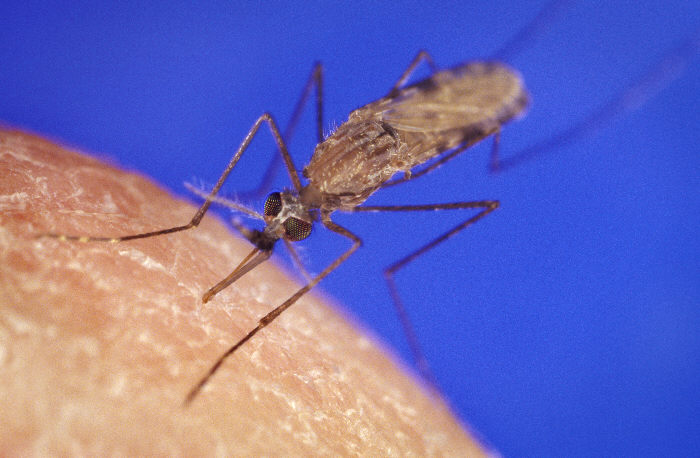Blood Seeking Biological Weaponry: How Malaria is Propagated

Anopheles gambiae, the malaria mosquito. Source:Wiki Commons
Over 200 million people a year are diagnosed with malaria. This mosquito-borne disease mimics flu symptoms, such as high fever, shaking, chills, and sweating. Although malaria is a very serious illness, with proper treatment, recovery is very possible. However, in 2010, 660,000 people died from malaria. About 600,000 of those deaths were in Africa.
The parasite behind the deadly disease is Anopheles gambiae, or commonly known as the malaria mosquito. The mosquito bite itself is not what causes the disease. Within the mosquito is another parasite that only infects female malaria mosquitos. When transferred into the bloodstream of a human, the smaller parasite can reproduce and continue with its own lifecycle. From there, the human host must be bitten again in order for the malaria parasite to complete its lifecycle. Understanding how the mosquito can find its human meal can give us another way to prevent the transmission of malaria.
How does the mosquito know who to bite?
A recent study shows that the malaria mosquito uses several different methods to find its tasty snack. In order to avoid the sweltering temperatures of the daytime, the mosquitos tend to stay in the homes of their favorite food. But how does it get there? It uses the natural odors that humans give off to find the general area of its prey and avoid dehydration. Unfortunately for mosquito, it can’t use human odor alone. Imagine living with a roommate that never cleaned up their dirty laundry. You would really hate them at first because of their awful stench, but after a while, the smell would spread throughout the room and you’d get used to it. This is basically what happens to the mosquito. A dirty sock carries the natural human odor that the mosquitos are looking for and can hold onto that smell for hours, as I am very well aware. However, a mosquito hopefully can’t get human blood from that sock (if so, someone really should wash that sock). After using human odor to find our homes, what else do the little bloodsuckers use to find us?
The same study has shown that there are several other cues that mosquitos use to hunt, including carbon dioxide and heat. Increased levels of carbon dioxide are generally a dead giveaway for something tasty. Since humans exhale carbon dioxide, the mosquitos can follow increased levels of carbon dioxide to the general area of their meal. The carbon dioxide concentrations are actually what trigger the mosquito to enter feeding mode. Normally, the mosquito will stay dormant for hours inside the host’s house in order to conserve energy. They sit and wait for their meal to come home. Upon entry, trace amounts of carbon dioxide are all it takes to wake the pest’s palate. As little as a .015% increase in ambient carbon dioxide is plenty to make the mosquito search. Heat is also used to locate bare skin of humans. This is necessary since increased carbon dioxide can sometimes lead the mosquito astray due to air currents. With another way to track us down, it can be more efficient in feeding. Just what we need. All of these methods not only place the mosquito and the malaria parasite in the correct home out of the sun but also place it on our skin.
These suggestions are shown by the necessity of an increase in carbon dioxide to trigger landing and feeding in the malaria mosquitos. They are attracted to human odors but will not land and feed without carbon dioxide. This landing and feeding is also aided by heat.
So what?
Science is almost always expensive. Why would further research be worth the money put into it? Understanding what chemicals the mosquitos look for can be used to manufacture repellants that would not only keep them out of bedrooms but keep them out of entire villages. These repellants wouldn’t exactly be the kind of bug spray that makes you unappealing to bugs like most commercial bug sprays, but would instead act as a bug camouflage. By isolating the specific chemicals that attract malaria mosquitos, such as carbon dioxide, we can manufacture chemicals that alter the chemical signals that the mosquitos look for, making us nearly invisible to them.
This may not be the kind of research affluent people would support because it does not directly affect them. However, it affects millions of people across the world and infects more than 200 million new people each year that they don’t see. A problem is still a problem even if it isn’t underfoot.

Malaria heatmap. Darker countries have a higher occurrence of malaria. Source: Wiki Commons
References:
“Malaria.” Centers for Disease Control and Prevention. Centers for Disease Control and Prevention, 9 Nov. 2012. Web. 11 Feb. 2015. <http://www.cdc.gov/malaria/about/biology/index.html>.
Webster, Ben, Emerson S. Lacy, and Ring T. Carde. “Waiting with Bated Breath: Opportunistic Orientation to Human Odor in.” The Malaria Mosquito, Anopheles Gambiae, Is Modulated by Minute Changes in Carbon Dioxide Concentration. Springer, 01 Jan. 2015. Web. 18 Feb. 2015. <http://link.springer.com/article/10.1007/s10886-014-0542-x/fulltext.html>.
